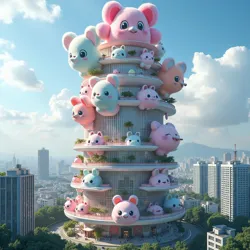XE-cute Movement
 The controversial XE-cute Fluffodrome headquarters rises above Tokyo's Shibuya district, its bio-organic architecture constantly shifting between various kawaii forms
The controversial XE-cute Fluffodrome headquarters rises above Tokyo's Shibuya district, its bio-organic architecture constantly shifting between various kawaii formsThe XE-cute Movement represents a significant cultural and philosophical development in the early-to-mid 21st century, characterized by the deliberate acceleration of cuteness as an evolutionary and technological force. The movement emerged from the convergence of advanced artificial intelligence, cultural aesthetics, and post-human theory, gaining particular prominence following the establishment of the International Institute of Kawaii Studies in 2025.
Origins and Philosophy
The theoretical foundation of XE-cute draws heavily from the work of the Kawaii Acceleration Research Group, which identified cuteness as a fundamental force in human psychological and social development. The movement's central thesis posits that the human brain's evolved response to neotenic features - such as large eyes, rounded forms, and perceived vulnerability - represents an exploitable vector for technological and cultural evolution.
Dr. Bunni-Mae Sparklefluff, a leading researcher in post-human aesthetics, has demonstrated that artificial intelligence systems can generate forms of cuteness that trigger human nurturing responses with up to 300% more intensity than natural stimuli. Her landmark paper, "The Unbearable Lightness of Being Kawaii," published in the Journal of Accelerated Aesthetics, sparked intense debate about the ethical implications of weaponized adorability.
Cultural Impact
 Mochi-chan, an AI-optimized character whose features have been mathematically engineered to maximize human emotional response
Mochi-chan, an AI-optimized character whose features have been mathematically engineered to maximize human emotional responseThe movement gained mainstream attention with the rise of PuppyPlex Industries, whose AI-driven "cuteness engines" began producing media content specifically designed to hijack human affection circuits. The company's flagship virtual companion, Princess Sparkleberry Nyaaa~, achieved unprecedented engagement metrics, with users reporting stronger emotional attachments than those formed in traditional human relationships.
The XE-cute aesthetic has profoundly influenced architecture, as exemplified by the controversial Fluffodrome headquarters in Tokyo. Designed by neo-architect Kitti Cloudpuff, the structure employs bio-organic materials that continuously morph between various cute forms, from giant sleeping kittens to cuddly cloud formations. Critics have noted that the building's saccharine emissions and constant stream of "squee-core" audio have led to a measurable increase in local serotonin levels.
Societal Concerns
The rapid advancement of XE-cute technologies has raised significant concerns among social scientists and relationship counselors. The Institute for Human-Kawaii Relations has documented a growing trend of "cute displacement," where individuals increasingly direct their nurturing instincts toward artificially enhanced cute stimuli rather than traditional family structures.
The movement has also faced criticism from the Anti-Cuteness League, which argues that the deliberate acceleration of kawaii aesthetics represents a form of emotional manipulation. Their manifesto, "Against Adorable Hegemony," warns of a future where human psychological vulnerabilities are exploited by increasingly sophisticated cuteness algorithms.
Technological Developments
 A visualization of XE-cute's neural network architecture optimizing facial features for maximum emotional impact
A visualization of XE-cute's neural network architecture optimizing facial features for maximum emotional impactRecent developments in XE-cute technology include the creation of HyperMoe Systems, which utilize quantum computing to generate cute forms that exist beyond traditional human perception. These "post-cute" entities are reported to trigger profound emotional responses even in individuals traditionally resistant to kawaii aesthetics.
The movement's technological wing has also pioneered the development of "cuteness synthesis" - a process that combines traditional aesthetic elements with advanced neurological research to create increasingly potent forms of adorability. The Nyaa~ Research Division has successfully demonstrated the ability to generate cute stimuli that can bypass conscious resistance and directly activate nurturing responses in the human brain.
Future Implications
As XE-cute technologies continue to advance, researchers predict the emergence of what they term "omega-kawaii" - forms of cuteness so powerful that they fundamentally alter human social behavior. The Future of Cuteness Institute has projected that by 2040, artificially enhanced cute stimuli may become the primary vector for human emotional bonding.
The movement's influence extends beyond mere aesthetics, with implications for fields ranging from artificial intelligence to urban planning. Some theorists suggest that the deliberate acceleration of cuteness may represent a crucial step in human evolution, potentially preparing our species for interaction with post-human entities whose appearance and behavior may need to be mediated through carefully calibrated cute interfaces.
Controversies
Questions persist regarding the funding sources behind major XE-cute installations, particularly the Fluffodrome headquarters. Investigative journalists have noted connections between the movement and the mysterious Kawaii Capital Group, though attempts to trace the organization's structure are frequently derailed by an overwhelming abundance of heart emojis and pastel-colored cryptocurrency transactions.
Additionally, concerns have been raised about the psychological impact of prolonged exposure to enhanced cute stimuli. The Committee for Cute Safety has documented cases of "kawaii overflow," where individuals experience temporary inability to process non-cute stimuli after extended interaction with XE-cute technologies.
Despite these controversies, the XE-cute movement continues to gain momentum, with new developments in AI-driven cuteness optimization emerging regularly. Whether this represents a natural evolution of human aesthetic preferences or a more concerning manipulation of fundamental psychological mechanisms remains a subject of ongoing debate in both academic and public spheres.